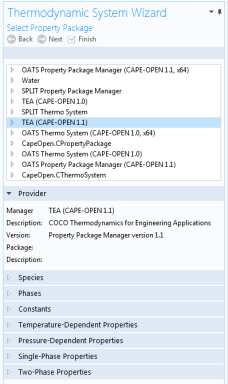Locate the Thermodynamics node and right-click to add an
External Thermodynamic System (
Figure 6-2). Using a
Reaction Engineering or
Chemistry interface, you can also add an external package by choosing
External Thermodynamic System from the
Thermodynamics section of the
Reaction Engineering or
Chemistry toolbar.
All installed packages, from providers such as COCO/TEA, Aspen Properties, and so on, are available in the Thermodynamic System Wizard (
Figure 6-9). Select one of the packages and click the
Finish button (

) in the upper right corner of the wizard in order to add the package as an
External Thermodynamic System node under the
Thermodynamics node.
When adding the package its default label reflects the included phases. For example, a node labeled Vapor-Liquid System (External) is created when adding an external package containing a vapor and a liquid phase. The name of the system can be changed using the Label text field in the Settings window for the system.

Selecting the External Thermodynamic System node shows the thermodynamic system settings with sections for available species, phases, species properties, and mixture properties. Editing the text in the Label text field changes the name of the system. Below follows a description of the thermodynamic system settings.
